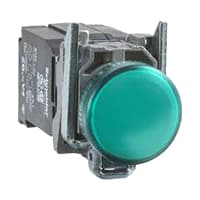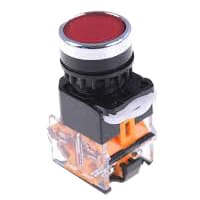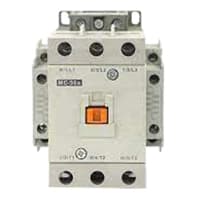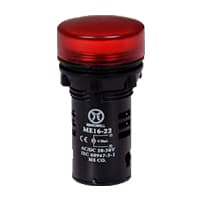Start Stop Button wiring diagram:
This diagram shows the Start Stop Button wiring diagram. In this circuit, we use a start switch, a stop switch, a timer, a contactor, a DP MCB, and two Indicator lamps. First, we need to connect the DP MCB ( Double Pole Miniature Circuit Breaker ), then connect the contactor with the timer and start-stop switch, and then connect the indicators with the circuit breaker.
Advertisements
Components needed For this Project:
You can get the components from any of the sites below:
- DP MCB 25A [See Buy Click Amazon]
- Push Button NO Switch [See Buy Click Amazon]
- Push Button NC Switch [See Buy Click Amazon]
- 8 Pin Timer 220V AC [See Buy Click Amazon]
- Magnetic Contactor 25A [See Buy Click Amazon]
- Indicator Light 220v AC [See Buy Click Amazon]
make a commission if you buy the components through these links. I would appreciate your support in this way!
Advertisements
Components used to make the Start Stop Button wiring diagram:
DP MCB In 2 Pole MCB, switching & protection is affected in phases and the neutral. A Double Pole or DP Switch is a Switch that Controls 2 Circuits at the same time. In terms of Residential Switching, this Normally means it Switches the live and Neutral at the same time. In Layperson Terms, Double Pole switches or DP Switches are Exclusively Designed to Control 2 Different Electrical Circuits at the same time, which allows the Appliances to Isolate safely and reliably. Fan or light Combinations and Medical Equipment are some of the many applications for DP Electrical Switches and Electrical components.
02. NO Switch:
NO (Normally Open) Terms Refer to a Type of Dry Contact or Wet Contact. A Push to Make Switch Allows Electricity to flow Between its 2 contacts when held in. When the button is released, the Circuit is broken. This type of Switch is also known as A Normally Open (NO) Switching system. As its name implies, a Normally Open (NO) Switch Contact or “a Contact” is a Switch. Put very simply, a Normally Open Sensor will have no Current When in a Normal State But When it Enters an Alarm State it will have +5V applied to the Circuit.
An NC (Normally Closed) Push Button is a Push Button That, In Its Default State, Makes Electrical Contact With The Circuit. An NC (Normally Closed) Push Button is a Push Button that, in its Default State, Makes electrical Contact With the Circuit. When The Button Is Pressed Down, The Switch no Longer Makes Electrical Contact And The Circuit is Now Open. When The Button is Not Pressed, Electricity Can Flow, But When it is Pressed The Circuit is Broken. This type Of Switch is Also known As a Normally Closed (NC) Switch.
04. Timer:
A timer is a type of time-switching device that controls and controls Electrical circuits and electrical and electronic devices through time setting (on/off). The timer is basically 8-pin. Like other controlling devices the timer has a coil and when this coil is magnetized, the timer works on/off. The timer has 2 common ends and each common end has normally close and normally open options. When the timer is set by time, the timer trips at the end of that time and turns the common is normally closed (on) to open (off) and normally open (off) to close (on). This is how the timer works.
A magnetic contactor is an electromagnetic switching device. It is generally used for controlling 3-phase Motors. The operation of a magnetic contactor is similar to that of a Relay. but a relay is used for low-power or low-voltage connections, and a magnetic contactor is used for high-power or high-voltage connections. As soon as the supply is applied to the magnetic contactor coil. its normally open contacts are closed and normally closed contacts are opened and the associated devices are also operated. This is how a magnetic contactor works.
06. Indicator:
An indicator lamp just Sounds Technical, Sometimes it is called a Supervisory light Indicator. Indicator lights are amber in color and can be located at the Front, the Rear, and Sometimes at the Side of the car on both the left And Right-hand sides. The Common colors used by Indicator lamps are red, yellow, blue, white, and green line system. A Panel Indicator Lamp Generally has up to 5 Differently Colored Segments to Indicate Various Conditions on the Machine or Process system.
Thank You for visiting the website. Keep visiting for more Updates.
Frequently asked questions
In a start-stop circuit featuring a relay, the coil of a contactor is generally interconnected with the start-stop control circuit operating at a lower voltage. Upon pressing the start button, the coil receives a power supply resulting in the generation of the magnetic field.
A vehicle start-stop system and stop-start system (also known as S&S, micro-hybrid, or micro hybrid electric vehicle (µHEV)) automatically shuts down and restarts the internal combustion engine reducing the amount of time the engine spends idling, thereby reducing fuel consumption, emissions.
This button serves to the replace the role of the vehicle key. So to turn on and off the engine of your vehicle, you don't need to use the key, just press the button. The Engine Start Stop feature also functions as an additional safety feature for the vehicle.
The goal of a Stop-Start system was to improve in-city fuel economy during stop-and-go driving. In most deployments, these systems could add 3-10 percent efficiency to the vehicle's fuel economy. Most of the vehicles see about 5 percent improvement.
The Start/Stop Cycle Count was the amount of times the hard disk spindle started to spin and stopped spinning. This spindle will power the supply up and start spinning whenever the drive is turned on or resumed from sleep.
Read more Single Phase Wiring
What is a kilowatt-hour (kWh) | kwh formula | What does kwh mean
Introduction to Electrical Units and CircuitskW and kWh on your electricity bill As your home uses electricity during...
What is the Difference Between kVA | What does KVA mean | kVA formula
Difference Between KVA ExplainedWhat does KVA Mean? There are technical terms aplenty when it comes to generators, and...
Power Factor | Power Unit | Energy | Electricity Unit
Power factor definition | Calculating Power FactorPower Factor Values In a purely resistive circuit, the power factor...







0 Comments